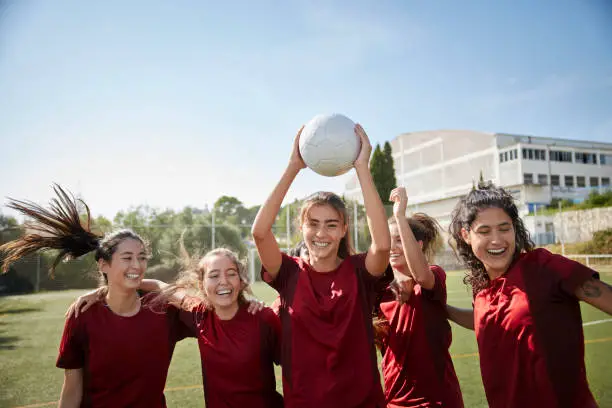When it comes to securing funding for sports programs, one of the most valuable resources to explore is sports foundation grants.
These grants, offered by various organizations, help fund sports initiatives that promote physical activity, build community engagement, and support the development of athletes from all backgrounds.
Whether you’re managing a youth sports league, aiming to expand your school’s athletic department, or working on a community-based sports project, sports foundation grants can provide the financial boost you need to reach your goals.
In this expanded discussion, we’ll dive deeper into what sports foundation grants are, the variety of programs they support, strategies for effectively securing these funds, and how you can leverage these opportunities to bring your sports vision to life.
What Are Sports Foundation Grants?
Sports foundation grants are financial awards given by foundations and organizations dedicated to fostering community development, youth advancement, health, and sportsmanship.
These grants are typically available to nonprofits, schools, community groups, and sometimes even individuals who are spearheading sports-related projects.
Unlike loans or investments, grants do not require repayment, making them an attractive option for organizations with limited budgets. They can cover a wide array of needs: from purchasing equipment and improving facilities to launching new programs that encourage widespread participation and skill development.
Fundamental to these grants is their alignment with specific goals such as community health improvement, inclusivity in sports, youth development, and the encouragement of a healthy lifestyle through physical activity. The generosity of sports foundation grants can mean the difference between a program that struggles to stay afloat and one that truly thrives and transforms lives.
Why Are Sports Foundation Grants Important?
Understanding the importance of sports foundation grants is crucial. They do more than just fund equipment or facilities; they invest in people and communities.
Here’s why they matter:
- Promoting Health and Wellness: Engaging in regular physical activity through sports can combat obesity, mental health issues, and chronic diseases. Sports grants often support programs that provide accessible ways for people to stay active.
- Fostering Community Cohesion: Sports bring communities together, bridging gaps between diverse groups and encouraging a spirit of collaboration. Community sports programs funded by grants can unite people across ages, races, and socioeconomic statuses.
- Providing Opportunities: Not everyone has access to organized sports due to financial barriers. Grants can ensure that children and adults from underprivileged backgrounds have the opportunity to engage in sports.
- Skill Development and Life Lessons: Participation in sports teaches teamwork, leadership, discipline, and resilience. These skills are invaluable life lessons that go beyond the playing field, contributing to personal development and success in various life areas.
Types of Sports Foundation Grants
To gain a comprehensive understanding, let’s look more closely at the different kinds of sports foundation grants and how they can benefit various types of programs.
1. Youth Sports Grants
Youth sports grants are particularly common, as many foundations see the long-term benefits of investing in young athletes. These grants often target programs aimed at children and teenagers, emphasizing areas such as:
- After-School Sports Programs: Many children spend long hours at school and may lack safe environments to play afterward. Grants can fund after-school sports clubs or leagues that keep kids active and engaged.
- Summer Camps: Sports camps can offer intensive training and fun activities during school breaks. Grants can make these camps free or affordable, ensuring all kids have the chance to participate.
- School Sports Teams: Public schools often lack funds for equipment, uniforms, or travel expenses for competitions. Grants can bridge that gap, allowing more students to participate.
For example, the Aspen Institute’s Project Play has reported that participation in sports increases graduation rates and improves academic performance. By securing a youth sports grant, you not only promote physical fitness but also contribute to academic success and personal growth.
Tip: When applying for youth sports grants, emphasize the long-term positive impact on children’s lives, including improved academic performance, better health outcomes, and enhanced life skills like teamwork and perseverance.
2. Women in Sports Grants
Women in sports grants are designed to support the advancement of female athletes and promote gender equality in sports. These grants fund initiatives that:
- Increase Female Participation: Programs that encourage girls to start or continue sports, breaking down cultural or societal barriers.
- Support Female Coaches and Leaders: Training and leadership programs that empower women to take on coaching and administrative roles.
- Create Safe Environments: Ensuring sports environments are safe and welcoming to women by addressing issues such as harassment and discrimination.
The Women’s Sports Foundation is a leading organization in this area, advocating for greater female participation and offering grants to various initiatives. They highlight the significant benefits of sports for women, including improved academic and career outcomes, higher levels of confidence, and stronger community ties.
Tip: When seeking a grant for women’s sports, illustrate how your program will empower women, create role models, and contribute to breaking down gender barriers. Share success stories and measurable outcomes that demonstrate positive change.
3. Adaptive Sports Grants
Adaptive sports grants focus on making sports accessible to individuals with disabilities. These grants support:
- Equipment Purchase: Specialized sports equipment such as wheelchairs, adaptive bicycles, or prosthetics.
- Program Development: Creating inclusive sports programs that adapt rules and facilities to accommodate different abilities.
- Facility Modifications: Adjusting existing sports facilities to be more accessible, including ramps, modified changing rooms, and accessible restrooms.
Organizations like the Challenged Athletes Foundation and the Christopher & Dana Reeve Foundation provide funding for adaptive sports initiatives. These programs not only empower athletes with disabilities but also promote a culture of inclusivity and diversity in sports.
Tip: Highlight in your grant proposal how your adaptive sports program will transform lives, foster inclusion, and provide athletes with the opportunity to excel. Provide examples of previous successes or testimonials from participants.
4. Community Sports Grants
Community sports grants are broad in nature and aim to benefit entire communities. They might support:
- Facility Construction or Renovation: Building new community sports centers, renovating outdated playgrounds, or creating safer sports fields.
- Inclusive Programs: Initiatives that integrate sports into community development, reduce crime rates, or improve community health.
- Public Health Campaigns: Programs that promote physical activity among all age groups, combating sedentary lifestyles and encouraging lifelong fitness habits.
The Robert Wood Johnson Foundation, for example, has funded numerous projects that incorporate sports and physical activities to improve community health outcomes.
Tip: When applying for community sports grants, showcase how your project will have a ripple effect on the community, such as reducing local crime, enhancing neighborhood bonds, or encouraging a culture of health and wellness.
5. Competitive Sports Grants
Competitive sports grants are aimed at supporting athletes and teams who compete at various levels. These grants can help cover:
- Travel Expenses: For tournaments, competitions, and training camps.
- Equipment and Uniforms: Ensuring athletes have the necessary gear to compete at their best.
- Coaching and Training: Funding for specialized coaching, facilities, or technology to improve performance.
Grants from organizations like the USA Track & Field Foundation or the U.S. Olympic and Paralympic Foundation often aim to develop athletic talent and support athletes on their path to high-level competition.
Tip: Emphasize how funding will directly lead to improved performance, increased opportunities for athletes, and potentially even medals or scholarships. Use data on success rates, testimonials from coaches, or athlete profiles to strengthen your proposal.
Where to Find Sports Foundation Grants:
Finding the right grant can be daunting. Here are some more detailed resources and tips to help you navigate the landscape of sports foundation grants.
a) Grant Databases
Online grant databases compile thousands of funding opportunities in one place. They are invaluable tools for finding sports foundation grants. Some popular options include:
- GrantWatch: Offers a searchable database where you can filter grants by category, including sports, youth, community, and more. They provide comprehensive details on each grant, including eligibility, deadlines, and application requirements.
- Instrumentl: This platform allows you to create a profile and receive personalized grant recommendations. You can set filters for sports-related funding opportunities and receive alerts for new grants.
- Foundation Directory Online: Managed by Candid (formerly Foundation Center), this resource provides detailed profiles of foundations, including their funding history, priorities, and grant opportunities.
b) National and Local Foundations
While online databases are powerful, building relationships and staying informed about specific foundations is equally important.
- National Foundations: Organizations like the NFL Foundation, US Soccer Foundation, and the Women’s Sports Foundation have dedicated sections on their websites outlining their grant programs, deadlines, and past recipients.
- Local Foundations: Regional sports councils, community trusts, and local government departments often have funding opportunities tailored to your area. These grants may not be as widely advertised but can be highly impactful locally.
Pro Tip: Subscribe to newsletters, follow relevant foundations on social media, and join community networks or forums where grant opportunities are frequently shared. This can provide timely updates on new opportunities and advice on how to approach applications.
Crafting a Winning Grant Proposal
Now that we’ve covered where to find grants and what types are available, let’s dive deeper into how to craft a compelling grant proposal. A strong proposal is the linchpin of securing funding. Here’s how you can create one that stands out:
1. Research Thoroughly
Before writing your proposal, fully understand the grant requirements and the mission of the foundation offering the grant. Look at past recipients to gauge what types of projects the foundation prefers and the impact they prioritize. This ensures that your proposal aligns with their goals, increasing your chances of success.
2. Create a Strong Introduction
Your proposal should begin with a powerful hook—a compelling story or statistic that underscores the need for your program. For instance:
“Did you know that over 60% of youth in our community lack access to safe sports facilities? Our program aims to change that by building a community sports center that not only provides a safe space for physical activity but also fosters community bonds and supports at-risk youth.”
This introduction sets the stage, engages the reader emotionally, and clearly conveys the importance of your project.
3. Outline Goals and Objectives
Be clear about what you aim to achieve. Use simple, conversational language to outline specific goals:
- Increase youth participation by 30% over the next year.
- Improve skills through certified coaching programs.
- Create an inclusive environment that welcomes individuals of all abilities.
Ensure these goals are specific, measurable, achievable, relevant, and time-bound (SMART). This not only makes your proposal concrete but also allows foundations to see a clear plan of action.
4. Demonstrate Impact with Data
Back up your claims with data and statistics. For instance:
- “According to the Women’s Sports Foundation, girls who play sports are 2.7 times more likely to excel academically. Our program aims to create opportunities that will mirror these benefits in our community.”
- “A report by the Aspen Institute highlights that inclusive sports programs can reduce dropout rates and improve community health metrics by over 20%.”
Incorporate charts, infographics, or case studies if possible. Visual representations of success stories or projected outcomes can be particularly persuasive.
5. Outline a Detailed Budget
Be transparent and detailed about how you’ll use the funds. Break down expenses clearly:
- Equipment: $5,000 for adaptive sports equipment
- Facility Renovation: $10,000 for upgrading the community sports center
- Staffing and Training: $7,500 for hiring certified coaches and staff training sessions
- Operational Costs: $2,500 for utilities, maintenance, and insurance
Explain why each expense is necessary and how it contributes to achieving your program goals. A well-thought-out budget increases credibility.
6. Highlight Sustainability and Future Plans
Funders like to know that their investment will have a lasting impact. Outline how your program will sustain itself beyond the grant period. Mention plans for future funding, community partnerships, or revenue-generating activities that will keep the program going.
7. Include Testimonials and Success Stories
Stories of how similar initiatives have succeeded or personal testimonials from those who have benefited from your program add a human touch. They illustrate the real-world impact of your work, making your proposal more relatable and compelling.
The Grant Application Process: Tips and Tricks
Even with a strong proposal, the application process can feel overwhelming. Here are some actionable tips to navigate it smoothly:
- Start Early: Grant applications often require a lot of paperwork and careful review. Begin well before the deadline to ensure you have ample time to gather all necessary documents, seek feedback, and make revisions.
- Follow the Guidelines: Every foundation has specific application guidelines. Whether it’s word count, formatting, or required documents, adhering strictly to these can make the difference between a successful application and one that gets discarded.
- Seek Feedback: Before submitting, ask colleagues, mentors, or even a grant writing expert to review your proposal. A fresh set of eyes can catch errors, suggest improvements, and ensure your message is clear.
- Build Relationships: If possible, connect with the foundation’s program officers. They can provide insights into what they look for in proposals and may offer advice on how to tailor your application.
- Keep Learning: Grant writing is a skill honed over time. Read articles, attend webinars, or take courses on effective grant writing techniques.
Remember: Persistence is key. Rejections are part of the process, but each application is a learning experience that hones your skills for the next opportunity.
Impactful Success Stories
To truly understand the power of sports foundation grants, let’s look at a couple of inspiring stories:
a) Community Transformation Through Youth Sports
A community in Ohio lacked safe spaces for children to engage in sports. An organization applied for a youth sports grant from a national foundation. With the funds, they built a state-of-the-art sports facility that offered basketball, soccer, and track programs.
The Impact:
- Over 300 youth joined the programs in the first year.
- School attendance improved as children had a positive, structured activity after school.
- Local crime rates slightly decreased as teens engaged in productive and supervised activities.
b) Empowering Women Through Sports
A nonprofit focused on empowering young women used a women’s sports grant to launch a soccer league specifically for girls. The program provided not only coaching but also mentorship and leadership training.
The Impact:
- Participation rates among girls increased by 50% within two years.
- Many participants reported improved self-esteem and leadership skills.
- Some athletes progressed to regional and national competitions, bringing recognition to their community.
These stories highlight that beyond the financial aid, the ripple effects of these grants can lead to sustained positive change.
Resources, Templates, and Tools for Grant Writers
Effective grant writing is both an art and a science. As you navigate this journey, leveraging the right resources is crucial.
To enhance your success rates and gain insider tips, strategies, templates, and tools, consider subscribing to the Grant Writing Academy Newsletter. Here’s what you can expect:
- Tips and Strategies: Learn from seasoned grant writers who share their experiences, challenges, and how they overcame them.
- Templates and Examples: Access a library of proposal templates, budgets, and sample letters that can serve as starting points or guides.
- Tools and Checklists: Utilize checklists for application processes, timeline templates, and budgeting tools to streamline your efforts.
- Case Studies and Success Stories: Regularly read about successful grant applications and learn what worked and why.
- Exclusive Webinars and Workshops: Participate in interactive sessions with experts in the field, offering Q&A sessions and personalized advice.
These resources can dramatically improve your grant writing skills, making you more confident and successful in your future applications.
Call to Action:
Ready to take your grant writing skills to the next level? Subscribe to the Grant Writing Academy Newsletter today and unlock a treasure trove of resources that will help you navigate the competitive world of sports foundation grants with ease!
Additional Resources and Support
a) Expand Your Knowledge
The grant writing field is always evolving. Keep learning and improving your skills to stay competitive.
Recommended Resources:
- Request for Proposal Success: How to Write Proposals That Win: Learn the techniques and strategies to create standout proposals.
- Tech Startup Funding Secrets: Navigating Grants for Maximum Growth: Perfect for those in the tech sector looking to leverage grants for scaling.
- Grant Proposal Guide for Environmental Projects: Tailored for environmental initiatives seeking to secure impactful funding.
- The Ultimate Guide to Federal Grant Applications: Techniques for Success: Master the complexities of federal grants with actionable insights.
Explore More Books Here
b) Invest in Expert Guidance
Want to fast-track your growth and achieve even more success?
Join one of our mentorship programs for tailored advice and support:
Mentorship Programs:
- 3-Month Mentorship: The Foundation Builder: A short-term plan to refine your grant writing skills and win your first (or next) grant.
- 6-Month Mentorship: The Proposal Pro: Dive deeper into strategies, proposal reviews, and funding plans.
- 1-Year Mentorship: The Funding Champion: Build long-term success with comprehensive guidance, unlimited reviews, and exclusive resources.
C) Book a One-on-One Consultation
Sometimes you just need personalized advice to tackle challenges or fine-tune your strategy. Let’s work together to solve your unique grant writing challenges.
Book a Consultation Call Here
Final Thoughts
Securing funding through sports foundation grants isn’t just about obtaining money—it’s about building healthier communities, empowering youth and women, making sports accessible to all, and fostering a culture of inclusion and excellence.
By understanding the landscape of available grants, crafting compelling proposals that speak to real-world impacts, and leveraging the wealth of resources and tips available, you can significantly increase your chances of success.
Remember: every application is an opportunity to refine your approach, learn more about what funders want, and ultimately, create a program that brings about meaningful change. With persistence, research, and the right support systems (like the Grant Writing Academy Newsletter), you’ll be well on your way to unlocking the funding that will transform your sports initiatives and the lives they touch.
Subscribe now to get started with expert guidance and become a successful grant writer who makes a lasting impact through sports!




